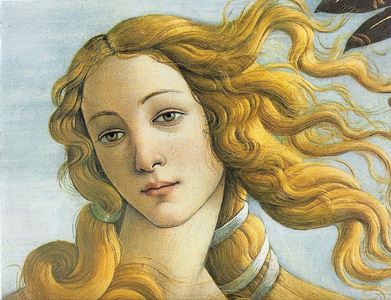When Simonetta Cattaneo walks into a room, conversations cease, and people turn to gaze in her direction. Love-struck swains gather in the streets beneath her window, hoping she’ll make an appearance. When first introduced to her, men pay her compliments so ridiculously flowery that she can’t help but stifle laughter.
Known as the most beautiful woman in late 15th-century Florence, Simonetta has gotten used to these and other reactions. She occasionally uses her looks to her advantage – who wouldn’t? – but, as a lover of poetry and literature in general, she yearns to be noticed for her mind.
Alyssa Palombo’s sensitively written second novel imagines the perspective of the stunning young woman depicted in multiple Renaissance-era paintings. It’s subtitled “a story of Botticelli,” but make no mistake, this is Simonetta’s tale. She comes from a minor noble family from Genoa, and at sixteen, she marries banker Marco Vespucci of Florence, and moves into his parents’ home. (Curiously, the senior Vespuccis are mostly absent.) Simonetta’s marriage gives her entrance into a world she longs to join: the intellectual circles of the powerful Medici family.
In Florence, which is presented in its gilded splendor, Simonetta befriends Lorenzo de’Medici and his wife, Clarice, and loves browsing the volumes in their palazzo’s library. Palombo paints Simonetta as a gentle personality eager to embrace the world opening up before her – and to fall in love with her kind, handsome husband. Still, she becomes intrigued by Sandro Botticelli, an artist who acknowledges her beauty but doesn’t flatter her.
Clever and level-headed, Simonetta is aware of the dangerous temptations Florence holds, and comes to learn that her beauty can’t protect her from deceptive behavior or, sadly, ill health – but she refuses to be a victim. Instead, she takes a bold step towards independence and passion that results in the glorious painting known as The Birth of Venus.
 |
| The Birth of Venus (close view), Botticelli, ca. 1484-86 |
Little is known of the historical Simonetta, and Palombo fills in the blanks with a romantic story about women’s agency, the consequences of beauty, and the communicative power of art. In keeping with its focus, the larger political issues of the day remain mostly in the background. It’s smoothly written from start to finish, and the inevitable finale will have you thinking about the life of this inspiring young woman for days afterward.
Alyssa Palombo's The Most Beautiful Woman in Florence was published in April by St. Martin's Griffin ($15.99, 320pp). Thanks to the publisher for sending a review copy earlier this spring.










This was wonderful, and so was the author's first novel, The Violinist of Venice. I recently interviewed her for Historical Novels Review.
ReplyDeleteI enjoyed reading the interview. Violinist of Venice sounds good - it's on the TBR.
DeleteThis sounds incredibly interesting - I've had it on my TBR for a little while now, I think I will have to bump it up. Lovely review!
ReplyDeleteThanks, Jordan! Let me know if you end up reviewing it also.
DeleteI doubt I will be able to track this book down. Thank you for a review on a book which sounds very very good.
ReplyDeleteThat's too bad - maybe a copy will turn up at some point later on? I hope so!
Delete